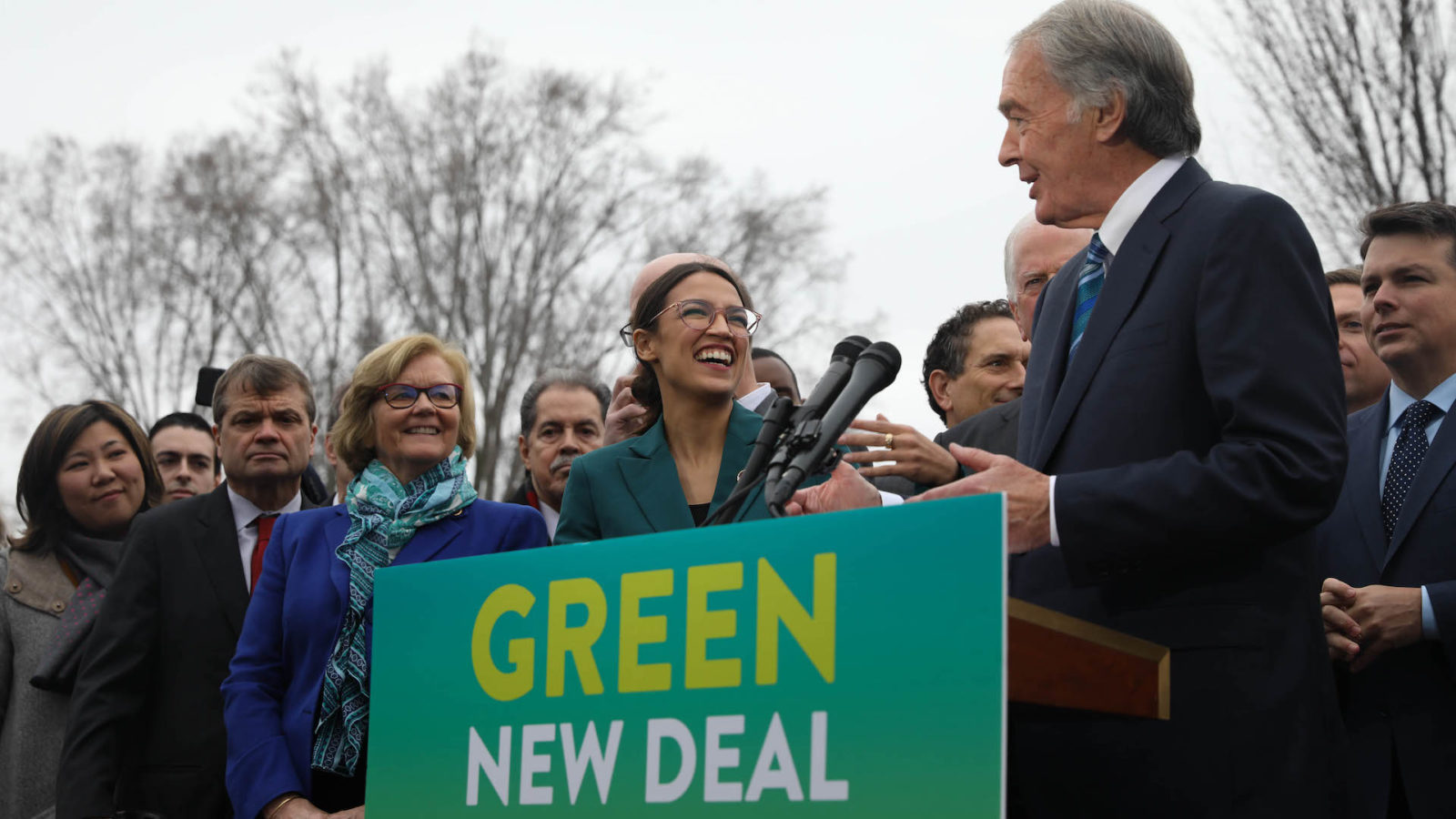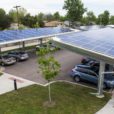More than two years ago, on a chilly February day, two of the nation’s most progressive lawmakers made headlines after introducing a resolution calling for a Green New Deal. This resolution — now a household name — laid out a plan for tackling climate change and creating clean energy jobs, while centering social and environmental justice.
Senator Ed Markey and Representative Alexandria Ocasio-Cortez didn’t come up with the notion of a Green New Deal — various iterations of it have been in circulation for decades — but the duo, alongside the proliferating youth Sunrise Movement, popularized the term in 2018 after AOC and a crowd of protesters sat outside of Nancy Pelosi’s office to demand bold climate action.
Since then, the Green New Deal has become a brand of politics and a governing philosophy — and has served as the foundation for a slew of introduced policies and provisions. Last month, several members of Congress reintroduced a package of Green New Deal bills, including the:
- Resolution to Create a Green New Deal, which outlines the framework for a comprehensive and ambitious plan to combat climate change by creating millions of high-wage jobs.
- Green New Deal for Cities Act, which funds city, state, local, tribal, and territorial governments to respond to the climate crisis in an equitable way.
- Green New Deal for Public Housing Act, which calls for an expansion of federal public housing and the complete decarbonization of this sector.
- Civilian Corps for Jobs and Justice Act, which establishes a diverse Civilian Climate Corps that will complete federally-funded projects that respond to climate change and transition to a clean economy.
Each of these policies is briefly summarized below:
Resolution to Create a Green New Deal
On April 20th, Representative Ocasio-Cortez and Senator Markey reintroduced the same joint Green New Deal (GND) resolution that first sparked a national debate two years ago. This 14-page resolution is non-binding, and Markey described it as a “revolution” that has already had an impact on climate policy successes to date.
“For so long, our movement toward a sustainable future has been divided with really just this false notion that we have to choose between our planet and our economy,” Ocasio-Cortez said when the legislation was unveiled. “And we decided to come together in sweeping legislation that not only rejects that notion, but creates a plan for 20 million union jobs in the United States of America.”
The resolution calls for a ten-year national mobilization that will completely transform and decarbonize the economy. It calls for 100 percent renewable energy and large-scale energy efficiency and conservation efforts. It also aims to address emissions from the agricultural sector, overhaul the transportation system, restore natural ecosystems, clean up hazardous waste sites, and achieve other lofty but scientifically-necessary goals. Critically, the resolution also creates an economic safety net for communities affected by climate change by guaranteeing healthcare and good-paying jobs for all.
Green New Deal for Cities
Alongside the GND resolution, Representatives Ocasio-Cortez and Cori Bush introduced the Green New Deal for Cities Act, which would distribute $1 trillion to cities, towns, and tribes over four years to enable the implementation of climate projects. This revenue can be allocated to a broad range of projects that:
- Improve transportation by installing new electric vehicle charging stations, building bike lanes, and improving public transit.
- Promote renewable energy by investing in solar, wind, and geothermal, and expanding access to broadband and community solar.
- Improve buildings and housing by creating more opportunities for affordable housing, electrifying homes, and instituting weatherization and energy efficiency measures.
- Prioritize local health by replacing lead pipes, testing for water and soil contaminants, monitoring air quality, investing in public sanitation, and conducting lead, mold, and asbestos remediation.
- Promote adaptation and resilience by restoring ecosystems, creating new public green spaces, procuring life saving machines and implementing adaptation measures.
- Remediate historical environmental injustice by supporting reparation programs for Black and Indigenous people and communities, among other things.
The bill requires local governments to work with community groups in order to prevent displacement, and ensures that new projects prioritize hiring locally-based individuals as well as women and people of color. The funding will be appropriated over the course of four years: $400 billion in 2022, descending by $100 billion per year through 2025. The Housing and Urban Development Secretary, in coordination with other key Biden administration figures, like the Secretary of Energy, Secretary of Labor, and Office of Domestic Climate Policy will allocate the funding.
Given that state legislatures are disproportionately conservative, giving money directly to local governments is particularly useful and will allow municipalities to advance environmental justice regardless of other political obstacles. Cities have already begun to capitalize on their opportunity to act on climate. More than 100 cities and towns across the country have committed to transition to 100% renewable energy, a list that includes cities in conservative states like Cincinnati, Ohio, Atlanta, Georgia, Columbia, South Carolina, and Salt Lake City, Utah. Additionally, several municipalities have adopted local versions of the Green New Deal, including New York City, Boston, and Los Angeles.
“St. Louis and communities across the nation need the Green New Deal for Cities,” said Representative Bush. “In St. Louis City, Black children are 2.4 times more likely than white children to test positive for lead in their blood, and are ten times more likely to visit the emergency room for asthma each year than white children. Black neighborhoods host the majority of the City’s air pollution sources […] this is a $1 trillion investment to tackle the environmental injustices that are making us and our children sick, costing us our homes, and destroying our planet.”
Green New Deal for Public Housing
Introduced by Ocasio-Cortez and Senator Bernie Sanders, this bill seeks to tackle the climate crisis and affordable housing shortage in one sweep. The Green New Deal for Public Housing seeks to electrify and repair the over a million public housing units in the country, while removing environmental toxins like mold and lead from homes. It will transition all public housing into zero-carbon, energy efficiency developments, while also removing existing limitations on building additional affordable housing.
“This bill shows that we can address our climate and affordable housing crises by making public housing a model of efficiency, sustainability and resiliency,” Sanders said. “Importantly, the working people who have been most impacted by decades of disinvestment in public housing will be empowered to lead this effort and share in the economic prosperity that it generates for our country.”
According to a report by the Climate and Community Project, the bill will create between 166,000 and 241,000 jobs per year. The policy will also result in enormous financial savings for the nearly two million individuals living in public housing; it will reduce public housing water bills by up to 30% per year, and energy bills by up to 70%.
Most importantly, it will significantly reduce energy consumption in the buildings sector, which is already responsible for about 40% of total domestic energy consumption. If passed, this legislation will result in an annual carbon emission reduction of about 5.6 million metric tons.
Civilian Corps for Jobs and Justice Act
In this bill, Ocasio-Cortez and Markey call for a Civilian Climate Corps that will put 1.5 million Americans to work. The idea stems from President Franklin D. Roosevelt’s Depression-era Civilian Conservation Corps, which employed three million men to plant billions of trees, fight forest fires, and build hiking trails.
“Our government has an opportunity to equitably reimagine an idea from the past and tailor it to meet the present and the future,” Senator Markey said. “The Civilian Climate Corps will provide an opportunity for millions of Americans from every walk of life to earn a good wage while serving their communities and training to transform our economy.”
Today, this large national service program will work to reduce carbon emissions, enable a transition to renewable energy, build healthier and more resilient communities, and implement conservation projects. Climate Corps members will restore wetlands and forests, retrofit buildings, and set up electric vehicle charging stations, among other things.
Climate Corps members will receive training and support in order to develop career pathways in green sectors, as well as generous employee benefits. While the program will utilize the existing structure of the low-paying AmeriCorps to start, it will ensure members are paid at least $15 an hour, receive healthcare and childcare benefits, and are allocated educational funding, such as an annual $25,000 educational grant that can be used to pay down student debt or fund further education. The Act calls for at least half of the climate service projects to be based in low-income communities and communities of color, and for at least 10% of projects to be in tribal areas.
In an interview with Grist, professor Mark Paul stated the need for such a corps: “There’s a massive amount of interest, and we certainly have no shortage of work to be done.”
Looking Ahead
It’s unlikely that this legislation will pass in its current form this session. However, many hallmark elements of the Green New Deal have already been incorporated into President Biden’s proposed climate plans, albeit not at the same scale.
For example, the American Jobs Plan calls for a civilian corps similar to the one Ocasio-Cortez and Markey outline, and allocates $10 billion for such an effort. However, that’s likely only enough to employ between 150,000 and 200,000 workers, a figure that pales in comparison to the 1.5 million workers Ocasio-Cortez and Markey hope will be hired. Similarly, while the GND for Public Housing is estimated to cost between $119 billion and $172 billion over the next decade, President Biden has proposed spending $40 billion on affordable housing.
Ultimately, with Democrats in the majority in both the House and Senate and Biden pledging to prioritize climate action in his term, it’s very likely we will see unprecedented climate action in the near future. Whether or not the scale of action matches the enormity of the crisis, however, remains to be seen.









